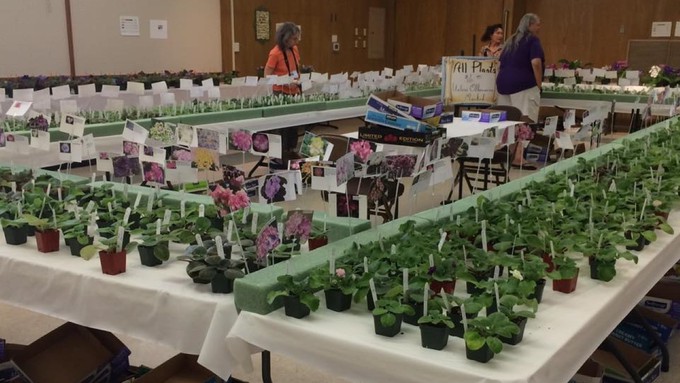
Capital City African Violet Society hosts annual event

Hundreds of African violet plants are arrayed at the Shepard Garden and Arts Center during a previous show and sale by the Capital City African Violet Society. Debbie Arrington
Today’s African violets aren’t plain old purple. They come in a dazzling array of patterns, shapes and colors – making them a most collectible houseplant.
Build your African violet collection with just one stop at the annual Capital City African Violet Society sale at Shepard Garden and Arts Center in McKinley Park.
On Saturday, April 6, find hundreds of rare and unusual varieties, many not available at local nurseries. They’re priced to sell quickly; get there early for best selection. The sale is open from 10 a.m. to 4 p.m., or until all the plants are sold. Admission and parking are free.
In addition to the sale, the society is hosting a beautiful display of members’ prized African violets in their peak of bloom. In addition to violets, see their close gesneriad cousin, cape primroses. Some of these eye-catching varieties also may be offered in the sale.
There are many reasons African violets have endured as a favorite houseplant. They live a long time with little care – and they bloom indoors!

African violets aren’t violets but they did originate in Africa, discovered in the tropical rain forest of Tanzania in 1892 by Baron Walter Von Saint Paul. The species’ botanical name, Saintpaulia ionantha, honors the German baron’s family; ionantha means “violet like.”
This little plant became an international phenomenon. A year after its discovery, it was patented to a German seed company. In 1894, Harris Seeds introduced the African violet to America.
But it was Woolworth & Co. that gets credit for making the African violet a national sensation. In 1927, a Los Angeles plant breeder introduced the hybrids ‘Sailor Boy’ and ‘Blue Boy,’ the first mass-marketed houseplants. Woolworth’s sold them in their stores across the country – the first time a chain store had sold plants on such a large scale. Millions were sold.
Nearly a century later, love of these fuzzy, flower-filled plants continues to grow.
For violet newbies, Saturday’s event is always a wonderful spot to get advice. Society members can show how to repot an overgrown plant and other care tips to prompt more blooms.
The club also offers supplies for growing African violets and other flowering houseplants.
Shepard Center is located at 3330 McKinley Blvd., Sacramento.
Details and directions: www.sgaac.org.
Comments
0 comments have been posted.Sacramento Digs Gardening to your inbox.
Sites We Like
Garden Checklist for week of May 5
Survey your garden after the May 4 rainstorm. Heavy rain and gusty winds can break the neck of large flowers such as roses. Also:
* Keep an eye on new transplants or seedlings; they could take a pounding from the rain.
* Watch out for powdery mildew. Warmth following moist conditions can cause this fungal disease to “bloom,” too. If you see a leaf that looks like it’s dusted with powdered sugar, snip it off.
* After the storm, start setting out tomato transplants, but wait on the peppers and eggplants (they want warmer nights). Pinch off any flowers on new transplants to make them concentrate on establishing roots instead of setting premature fruit.
* Trim dead flowers but not leaves from spring-flowering bulbs such as daffodils and tulips. Those leaves gather energy to create next year's flowers. Also, give the bulbs a fertilizer boost after bloom.
* Pinch chrysanthemums back to 12 inches for fall flowers. Cut old stems to the ground.
* Mulch around plants to conserve moisture and control weeds.
* From seed, plant beans, beets, cantaloupes, carrots, corn, cucumbers, melons, pumpkins, radishes and squash.
* Plant onion sets.
* In the flower garden, plant seeds for asters, cosmos, celosia, marigolds, salvia, sunflowers and zinnias. Transplant petunias, zinnias, geraniums and other summer bloomers.
* Plant perennials and dahlia tubers for summer bloom.
* Don’t wait; plant summer bulbs, such as gladiolus and tuberous begonias.
* Harvest cabbage, lettuce, peas and green onions.